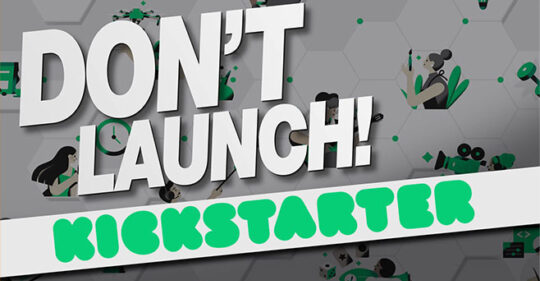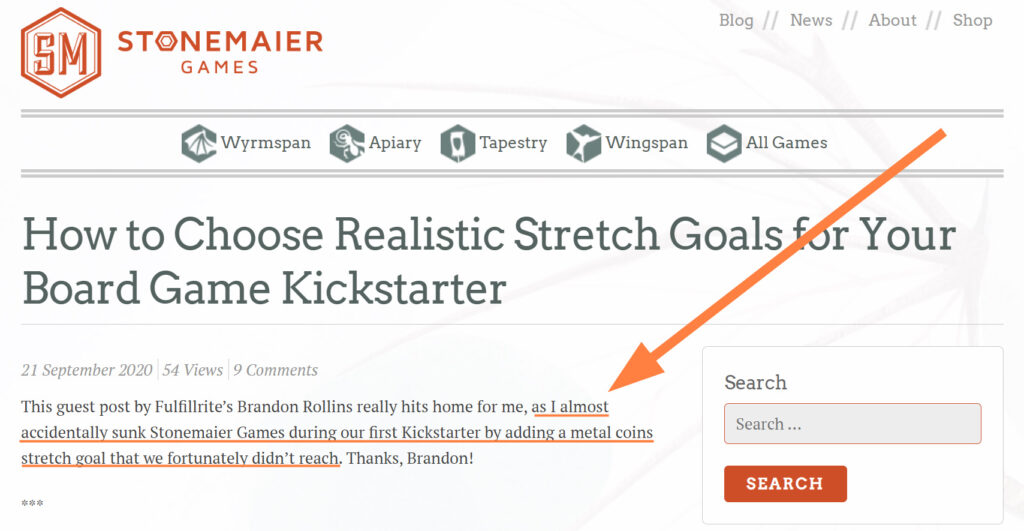Read This Before Launching On Kickstarter
February 12, 2024
The big day is incoming, and you have built a crowd that is frothing at the mouth for your Kickstarter launch.

Before you go all Leeroy Jenkins on launch day, you should know that there are some simple mistakes that could catastrophically doom your Kickstarter before it even gets off the ground.
Small mistakes, but massive problems.
The shortlist of catastrophic doom™ below is not theory – This stuff comes from first-hand case studies, some from our very own experiences. Each of these represents how a creator nearly doomed, or in fact, did doom, their own campaigns.
So buckle in, get a pen, and jot some notes.
It’s gonna get nerdy.
#1 Don’t Charge Shipping In Your Pledges
There are a couple of things you can’t change when you finally publish your Kickstarter campaign.
One of these is your shipping price.
There are multiple reasons why you should never charge shipping in a pledge for Kickstarter:
1. Shipping rates are volatile. “Last mile” shipping (known as the cost to get a package from your warehouse to your customer) increases every year. Planning for volatility will help you out. You might expect you’ll deliver in the same year you fund, but failing to calculate for project delays might push your “last mile” fulfillment into the following year, where a 10% cost increase is the minimum you should expect on every package you ship.
In addition to “last mile” shipping, Freight shipping (the process of moving your product from China on the ocean to your warehouses) can quite literally change from day to day. Speaking of volatility, the shipping fiasco during the COVID-19 years saw insane increases. Chris Birch of Modiphius Entertainment explains that shipping rates from China to Europe jumped from $6,000 per container to $36,000 during the height of the shipping crisis in 2021 (See at 41:15 below).
Locking in your shipping numbers and charging for them before you have even started manufacturing is a recipe for total annihilation. A 10% increase may only represent $2 or $3 per backer, but it can represent catastrophic doom™ all by itself if you have little margin for error (or a ton of backers).
For this reason, you should always present an estimate of shipping on your campaign based on the current estimates with a clear explanation to backers that the numbers listed are likely to change.
2. Kickstarter takes a 5% cut from anything you raise on their platform. That includes shipping. We can’t fathom why someone thought it’s a good idea to take a 5% cut from your shipping in addition to processing fees, but that’s what they do. If you charge shipping through Kickstarter, you need to charge 10% more to break even.
We recommend only estimating shipping on your campaign, but charge $0 for shipping during your campaign, and then use a pledge manager like Hive Interactive that charges 0% fees on shipping.
Not only will you save that small 5%, but you will be able to delay the shipping charge. This has several big benefits – one being that you get to avoid catastrophic doom™ to your campaign through an unexpected shipping increase.
The other major benefit is that you get to split the financial hit your backers take on your campaign over time. It becomes easier to back the pledge level they want, since the charge for shipping may be delayed by several months (or years in some more extreme cases).
Don’t charge shipping in your Kickstarter pledges - Use a Pledge Manager
Write that down and memorize it!
#2 Know Your Numbers
Getting your numbers wrong almost always threatens catastrophic doom™ to your campaign and can destroy your reputation.
Your ability to manufacture and ship tabletop games boils down to having enough in your company bank account to make that happen. This includes feeding yourself and keeping the lights on if you rely on this crowdfunding initiative for income. In this high-stakes crowdfunding numbers game, seemingly insignificant changes could have devastating consequences when scaled with manufacturing.
In fact, Jamey Stegmaier of Stonemaier Games (a company many of us know and love) nearly tanked his entire company with a misplaced stretch goal in his very first Kickstarter, Viticulture.

One question every creator should define for themselves is: How will I know what success looks like?
Some may be doing this for the money, and others may be doing it to see their idea come to life… But let’s assume that in every single crowdfunding campaign, delivery of the promised product is included. And since there is nothing wrong with making money doing what you love, let’s also include “breaking even” as a minimum threshold of success.
You can’t confidently know you’re going to deliver and break even unless you also know:
- The amount of backers you need to be profitable
- Average pledge value to maximize returns
- Your manufacturing costs
- Shipping costs
- Tax / Import costs
- Marketing expenses
- Etc.
If you don’t know your numbers, you are likely going to lose money. In many cases, you will lose a LOT of money, and in a majority of these, your ability to deliver anything will meet catastrophic doom™.
We have seen many well-meaning crowdfunding creators or even successful crowdfunding companies over the years fail to deliver. In every case, they promise something that appears doable in the campaign story, but in fact, did not include a realistic picture of the numbers or costs required to deliver.
Some companies have an artificially low funding goal because they think they’ll blow past it and get the $1M they need to make this. Other companies spend little time on the numbers and go with their gut feeling, expecting they’ll figure it out as they go.
When assumptions fail, the only way these companies can survive is to ask their backer for more money. That destroys a reputation as fast as admitting an inability to deliver.
Hidden costs can wreck your campaign, and you need to ensure that you have crossed your t’s before making any promises to your backers. And yes, your crowdfunding campaign is a promise that you will do all in your power to deliver the product.
This is why selecting your partners, such as Crowdfunding Nerds, is super important. Solid counsel can prepare you for the unknown. We can warn you of unaccounted expenses in your plans or point you to our industry specialists who have specific expertise in areas that matter like shipping, manufacturing, VAT taxes, and more.
Don’t launch without first getting some solid counsel from folks who have successfully traversed the difficult path you’re about to tread upon.
#3 Send All Your Launch Day Notifications ASAP!
Sometimes it’s the little things that cause catastrophic doom™.
With so much to do on the day of launch, it is easy to forget that you have to actually announce your campaign is live.
You need your people to get notifications from everywhere all at once. They should receive an email letting them know that your campaign is now live and they can back. They need a Facebook group notification with a link using the “@everyone” tag. Your Discord server needs an announcement. Your personal Facebook page needs a post. You need to send that Instagram update, the TikTok vid, the tweet, and release the YouTube video on your channel.
All of this should happen within 5 minutes of pressing that launch button and confirming you are live (or as soon as humanly possible).
If you’re doing what you should be doing, you have a pre-marketing email list that you have been cultivating for this moment. You should have prepared your email list for this moment ahead of time. Don’t delay on that launch day email!
Delaying your launch day email by 4 hours could result in half your day 1 funding. It’s absurd the amount that this matters.
There are times we had to remind our clients to send this email out when we noticed they have not done so. It’s easy to miss, so write a list of everything that needs to be done on launch day and stick to it.
If you don’t know how to build your email list before launch, learn how we do it for our clients.
#4 Your Kickstarter Page Needs To Be Laid Out Clearly
In 2021, we interviewed Kickstarter Super Backer and Man Vs Meeple board game reviewer Jeremy Howard to figure out what matters most to backers on crowdfunding pages.
He explained his “three scroll test” - essentially stating that if he is not hooked within three scrolls, he moves on.
But in the several years since (and nearly 200 Crowdfunding Nerds episodes later), we find that an underwhelming FIRST scroll is enough to bring you to the brink of catastrophic doom™, and will certainly hinder your campaign’s success.
Ouch.
This is why it is essential that you meticulously plan and layout your Kickstarter/Gamefound page to be as clear and attractive as possible right from the very start.
Consider implementing the following when designing your page:
- Answer the question, “What is it?” in well-defined text with an attractive image visual aid on the very first scroll.
- Consider our basic “Hygiene Factors” and make sure to include them in your campaign.
- Put the most important information at the top of the page (3 scroll test.)
- Highlight keywords so people can skim-read your page.
- Use large image headlines to separate “content blocks” for easy reading.
- Show, don’t tell. Allow a prospective backer to draw their own inferences from the information you have presented on your page.
- Show, don’t tell … again: Don’t tell them all the rules. Don’t force them to watch the review video or playthrough video. Give them the summary, then include links to helpful resources (like your rulebook or reviewer/gameplay vids).
- Focus on what makes your project unique.
- Make sure it’s mobile-friendly by reading all text on your phone and checking load speeds on mobile data internet connections. Mobile is more important than Desktop. Tiny image text on mobile devices is far worse than extra large text on desktop devices.
- Copy success - review and copy the page layout of other successful projects on Kickstarter if you’re not sure how to lay out your content blocks.
- Leverage social proof - use reviews, quotes, and even list your industry partners to build backer confidence and rapport.
As a last point here, make sure to get eyes on your campaign before you launch for critical feedback. Get your community to leave feedback on your project preview or a fresh pair of eyes from a trusted colleague or editor to look things over.
We can review your Kickstarter or Gamefound page and provide a detailed report before your launch to ensure you are setting off on the best foot possible.
Where To Go From Here?

There is plenty more to cover on this important topic. For this reason, we recommend that you familiarize yourself with the podcasts below and consider joining the Crowdfunding Nerds Academy where we show you in step-by-step video tutorials of our tried and tested process that has helped hundreds of first time Kickstarter creators fund on day 1.
If you have any questions you can reach out to us directly in the Crowdfunding Nerds Community.
Godspeed, Nerds!
For more awesome articles about marketing for crowdfunding, join our e-mail list!
Crowdfunding Nerds Articles

Copyright 2023 Crowdfunding Nerds. All Rights Reserved. By Next Level Web








